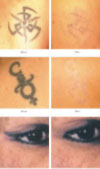
- Laser
Q-switched Nd:YAG 1064 nm.
This laser is most suitable for darker skin. This laser wavelength is best absorbed by tattoo pigments such as blue and black. Hence, it is very effective in blue and black coloured tattoos. It will have to be used in combination with other lasers for tattoos with red, green, yellow pigment.
Q-switched Frequency-doubled Nd:Yag 532 nm, Q-switched Ruby 694 nm, Q-switched Alexandrite 755 nm are the other Q Switched systems but are less used due to side effects such as pigmentary changes in darker skin types. Ghost tattoos may remain. Amateur tattoos respond better than professional ones.
Picosecond or Picosure is another option - Resurfacing
Resurfacing of tattoos removes only the top layers of the skin bearing the pigment of the tattoos. This technique may not always remove the pigment present in the deeper layers of the skin.Dermabrasion or aggressive surgical resurfacing is reserved only for an extreme situation and laser resurfacing can be added to Q switchedin stubborn cases. - Dermabrasion
- Ablative lasers like CO2 laser and Erbium Yag Laser
- Both these techniques may require local anesthesia. Because some bleeding is likely to occur a dressing is applied immediately to the area.
-
Resurfacing can be done through
PRE- AND POST-PROCEDURE INSTRUCTIONS
Stop all medicated creams 2 days before and 5 days after the treatment
Apply an antibiotic cream twice daily for 5 days after the procedure
Follow the cleansing and moisturizing routine from the second day onwards
Apply sunscreen of minimum SPF 30 after the treatment
Avoid threading / waxing / bleaching on face for 7 days after the treatment
POST-PROCEDURE SYMPTOMS
1st–2nd day – redness and swelling will be noticed
3rd–5th day – brownish discolouration followed by scab formation occurs. Avoid manual removal of scabs
